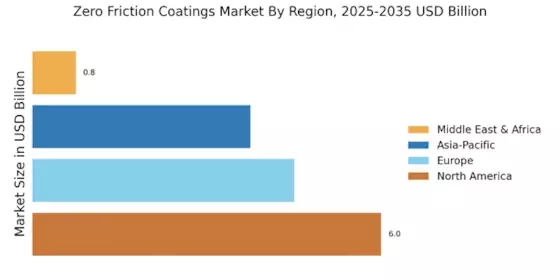Rising Demand for Energy Efficiency
The Zero Friction Coatings Market is experiencing a notable surge in demand driven by the increasing emphasis on energy efficiency across various sectors. Industries such as automotive, aerospace, and manufacturing are actively seeking solutions that minimize energy consumption and enhance performance. Zero friction coatings, known for their ability to reduce wear and tear, contribute to improved energy efficiency by lowering friction between moving parts. According to recent estimates, the adoption of these coatings could lead to energy savings of up to 30% in certain applications. This trend is likely to propel the Zero Friction Coatings Market forward as companies strive to meet sustainability goals and reduce operational costs.
Advancements in Coating Technologies
Technological innovations are playing a pivotal role in shaping the Zero Friction Coatings Market. Recent advancements in coating technologies, such as the development of nanostructured coatings and advanced polymer composites, are enhancing the performance and durability of these coatings. These innovations not only improve the friction-reducing properties but also expand the range of applications for zero friction coatings. For instance, the introduction of self-lubricating coatings has opened new avenues in industries like electronics and medical devices. As these technologies continue to evolve, they are expected to drive growth in the Zero Friction Coatings Market, attracting investments and fostering competition among manufacturers.
Expanding Applications in Diverse Industries
The versatility of zero friction coatings is contributing to their increasing adoption across a wide array of industries, thereby driving the Zero Friction Coatings Market. These coatings are being utilized in sectors such as automotive, aerospace, electronics, and medical devices, where friction reduction is critical for performance and longevity. For example, in the automotive industry, zero friction coatings are applied to engine components to enhance fuel efficiency and reduce wear. The expansion of applications is expected to create new opportunities for manufacturers, as they seek to cater to the specific needs of different sectors, further propelling the growth of the Zero Friction Coatings Market.
Growing Awareness of Maintenance Cost Reduction
The Zero Friction Coatings Market is witnessing growth fueled by the increasing awareness among businesses regarding maintenance cost reduction. Companies are recognizing that the implementation of zero friction coatings can lead to significant savings in maintenance and replacement costs over time. By minimizing wear and tear on machinery and components, these coatings extend the lifespan of equipment, thereby reducing the frequency of repairs and replacements. This realization is particularly evident in industries with high operational costs, such as manufacturing and transportation. As organizations continue to prioritize cost efficiency, the demand for zero friction coatings is expected to rise, further enhancing the prospects of the Zero Friction Coatings Market.
Increasing Regulatory Pressure for Emission Reductions
The Zero Friction Coatings Market is also influenced by the growing regulatory pressure aimed at reducing emissions and enhancing environmental sustainability. Governments worldwide are implementing stringent regulations to curb greenhouse gas emissions, particularly in the transportation and industrial sectors. Zero friction coatings can play a crucial role in meeting these regulatory requirements by improving the efficiency of engines and machinery, thereby reducing fuel consumption and emissions. As industries adapt to these regulations, the demand for zero friction coatings is likely to rise, positioning the Zero Friction Coatings Market as a key player in the transition towards greener technologies.


















Leave a Comment